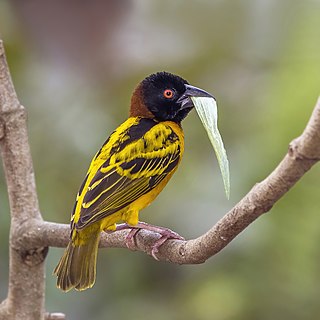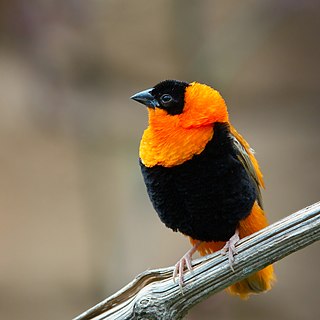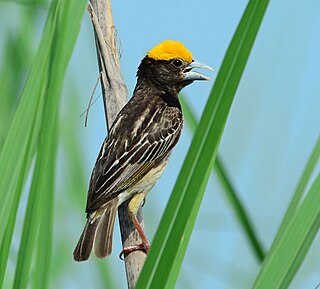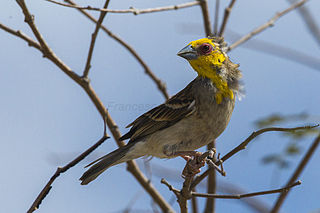
The village weaver , also known as the spotted-backed weaver or black-headed weaver, is a species of bird in the family Ploceidae found in much of sub-Saharan Africa. It has also been introduced to Portugal and Venezuela as well as to the islands of Hispaniola, Martinique, Puerto Rico, Mauritius and Réunion.

The northern red bishop or orange bishop is a small passerine bird in the family Ploceidae. It is part of the largest genus in the family with over 60 different species. Its sister species is the Southern red bishop. This species is most recognizable by the bright reddish orange with contrasting black plumage displayed by the breeding male. It is most common throughout the northern African continent but has also been introduced to areas in the western hemisphere.

The red-billed quelea, also known as the red-billed weaver or red-billed dioch, is a small—approximately 12 cm (4.7 in) long and weighing 15–26 g (0.53–0.92 oz)—migratory, sparrow-like bird of the weaver family, Ploceidae, native to Sub-Saharan Africa.

The Cape weaver is a species of bird in the weaver family, Ploceidae, found in southern Africa.

Speke's weaver is a familiar East African songbird.

The black-breasted weaver, also known as the Bengal weaver or black-throated weaver, is a weaver resident in the northern river plains of the Indian subcontinent. Like the other weavers, the males build an enclosed nest from reeds and mud, and visiting females select a mate at least partially based on the quality of the nest.

The southern masked weaver, or African masked weaver, is a resident breeding bird species common throughout southern Africa.

The baglafecht weaver is a species of weaver bird from the family Ploceidae which is found in eastern and central Africa. There are several disjunct populations with distinguishable plumage patterns. Only some races display a discrete non-breeding plumage.

The Taveta weaver, also known as the Taveta golden weaver, is a species of bird in the weaver family, Ploceidae. It is found on the African savannah in Kenya and Tanzania. The name of the bird comes from the unique markings/coloration of the bird, as well as how these birds weave intricate nests.

The black-headed weaver, also known as yellow-backed weaver, is a species of bird in the family Ploceidae.

The nelicourvi weaver is a species of bird in the family Ploceidae. It is endemic to Madagascar. Together with its closest relative, the sakalava weaver, it is sometimes placed in a separate genus Nelicurvius. A slender, sparrow-like bird, it is 15 cm (5.9 in) long and weighing 20–28 g (0.71–0.99 oz). Breeding males have a black bill and head, brown eyes, yellow collar, grey belly, chestnut-brown lower tail coverts, olive back, and blackish flight feathers edged greenish. Non-breeding males have mottled grey and green heads. In the breeding female the front of the head is yellow and the back olive green, with a broad yellow eyebrow. It builds solitary, roofed, retort-shaped nests, hanging by a rope from a branch, vine or bamboo stem, in an open space. It primarily feeds on insects, looking on its own or in very small groups, often together with long-billed bernieria. Its natural habitat is subtropical or tropical moist lowland and mountain forests. The conservation status of Nelicourvi weaver is least concern according to the IUCN Red List.

The Sakalava weaver sometimes known as the Sakalava fody is a species of bird in the family Ploceidae. It is endemic to Madagascar. The bird is 15 cm (5.9 in) long and weighs 20–28 g (0.71–0.99 oz).

The southern red bishop or red bishop is a small passerine bird belonging to the bishop and widowbird genus Euplectes in the weaver family, the Ploceidae. It is common in wetlands and grassland in Africa south of the Equator. North of the Equator, it is replaced by the northern red bishop or orange bishop which was formerly regarded as a subspecies of this species.
















